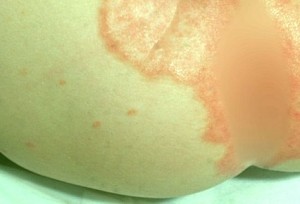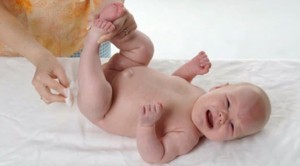Diaper rash occurs when a baby has a continuously wet or infrequently changed diaper. This rash is a form of dermatitis or inflamed skin and appears as patchwork of reddened bright skin. Diaper rash may also be caused by diarrhea and use of pants made of plastic to cover diapers. When breastfeeding mothers take certain kinds of foods or solid foods are added to diet of a baby, a diaper rash may develop. If your baby is on antibiotics, a diaper rash may also occur.
Symptoms of diaper rash
A diaper rash is characterized by red, puffy and tender skin in the area covered by the diaper including buttocks, genitals and thighs. A baby may also seem uncomfortable especially when changing a diaper. The baby will cry or fuss when the area covered by a diaper is touched or washed. The rashes may occur intermittently when a child wears diapers.
Diaper rashes occur profoundly in the first 15 months being prevalent in between the 9th and 12th month. Treating a diaper rash is easy and the symptoms will improve within a few days with home treatments. However, if it does not improve with over-the-counter medication, you may need to consult your doctor.
The diaper rash can lead to secondary infections, which need to be treated with prescription medications. If you notice that a child has severe rash that worsens even after treatment, it is important that you consult a doctor. In addition, if the rash is accompanied by fever, blisters, boils, unusual sleepiness, rashes extending beyond the area covered by the diaper or weeping discharge, you may also need to consult a doctor.
Causes of diaper rash
This rash can be caused by many aspects and one is irritation from stool and urine. Because the baby’s skin is sensitive, a prolonged exposure to feces and urine could irritate it. If your baby is experiencing frequent bowel movements than urine, then he or she may be more prone to diaper rash. Introduction of new foods may be another cause.
When babies begin taking solid foods, the content of the stool increases the probability of having a diaper rash. In addition, when the frequency of stool increases due to changes in diet, this may as well lead to a diaper rash. A baby who is breastfeeding may develop a diaper rash because of some food taken by the mother.
Introducing new products to the baby such as disposable wipes is another cause of the rash. If you use a brand new disposable diaper, a detergent, fabric softener, or bleach in washing cloth diapers, this could irritate the delicate skin. Yeast, fungal and bacterial infections are also said to bring in rashes. When the area covered by a diaper becomes moist and warm, it makes the skin more delicate and vulnerable to infections.
Moreover, babies who have sensitive skin like atopic dermatitis or eczema also develop rashes more often than others do. However, the irritation on atopic dermatitis and eczema basically affects other areas than the diaper area. If you dress the baby with tight-fitting diapers, they can rub against the skin and cause rashes. Last but not least, antibiotics that kill bacteria can cause diaper rash because the bacteria that keep yeast growth in balance could be depleted.
Treatment of diaper rash
The most excellent treatment is to ensure that you keep the skin of your baby clean and dry. However, if the rash persists even with use of home treatments, you may consult your doctor. A mild hydrocortisone cream may be prescribed by your doctor. An antifungal cream is helpful if a fungal infection has affected the area with rashes.
In addition, tropical or oral antibiotics are taken to treat bacterial infection. Strong steroids need not be used frequently as they can lead to more problems. This is why it is recommended that cream and ointments that contain steroid are only used under the guidance of a dermatologists or pediatrician.
Home Remedies for Diaper Rash and Prevention
There are simple strategies that may help decrease the chances of developing diaper rash. Changing diapers as often as possible may assist to prevent the rash. Dirty diapers need to be removed punctually. As part of the diaper change, you need to rinse the bottom with water. You may use a water bottle, tub, sink, moist washcloths and cotton balls to clean the bottom. You should not use wipes containing fragrance or alcohol.
After washing, you should pat your baby with dry clean towel and not scrub the bottom because it can lead to irritation. Diapers should not be over tightened as this can prevent circulation of air in the area covered with a diaper. Chafing at the thighs and waist can occur due to tight-fitting diapers.
It is important to keep the bottom without diapers for some time. This allows the skin to dry naturally thus preventing more rashes. Soiled cloth diapers should be washed carefully by presoaking and using hot water to rinse them. You need to use mild detergents and skip use of fabric softeners because they may contain fragrances.
Diaper Rash Pictures


